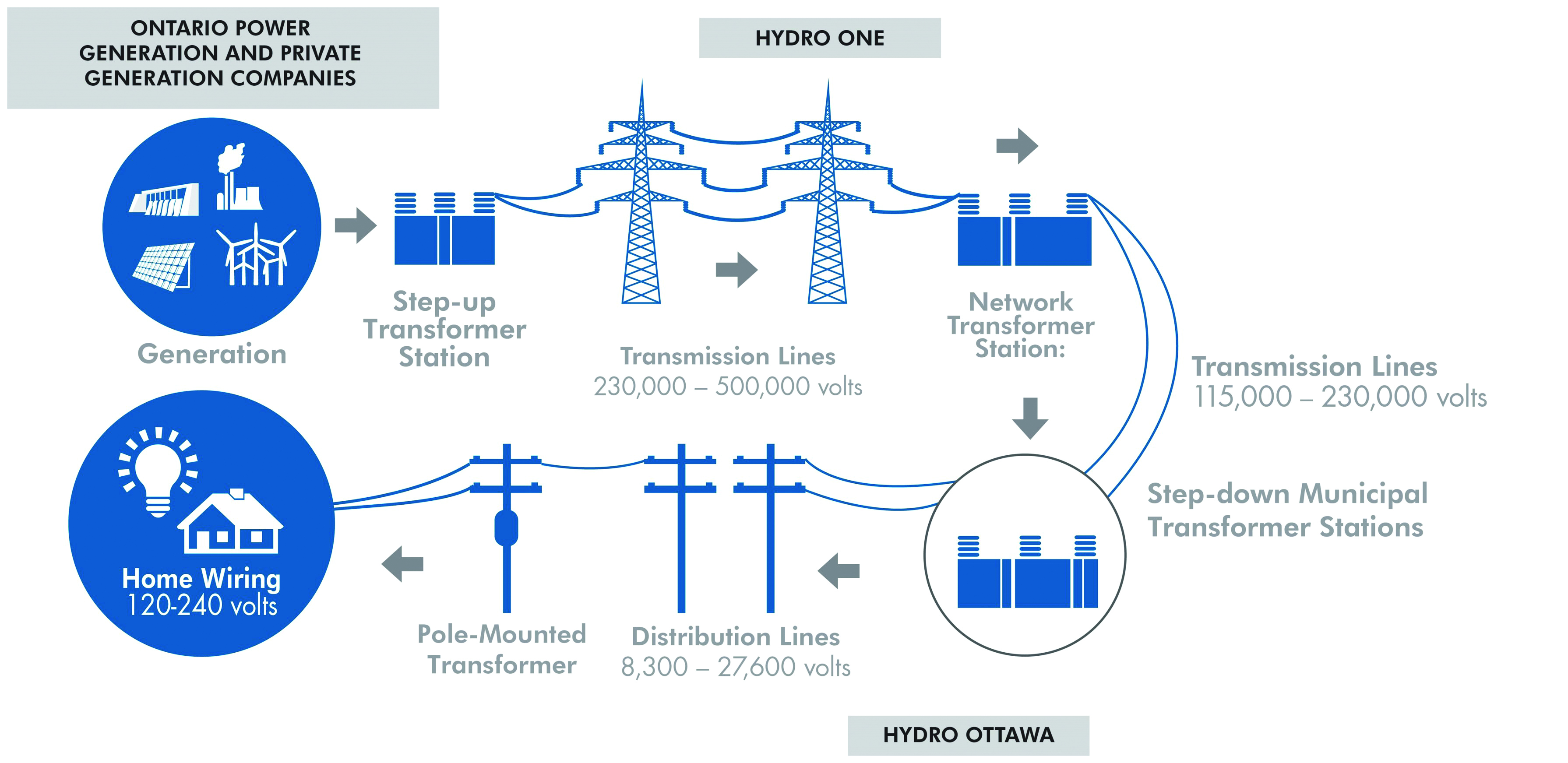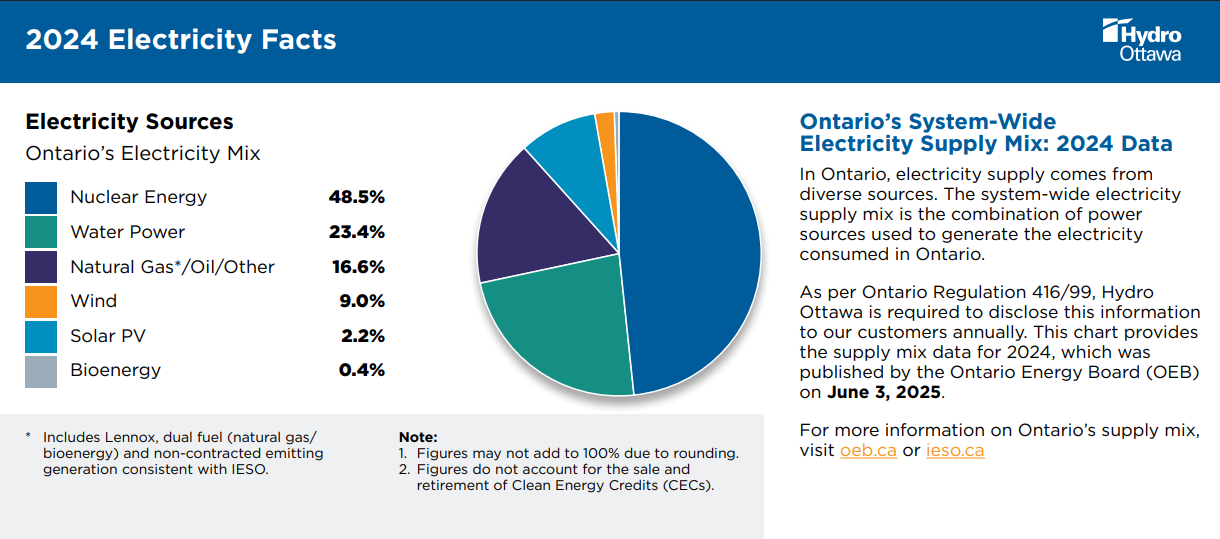Ever stare at your monthly hydro bill and wonder what all those lines mean? You're not alone. Understanding your electricity statement can feel a bit like deciphering a secret code. But don't worry, we're here to break it down and help you understand exactly what you're paying for.

Before we dive into the details of your bill, have you ever wondered how our electricity costs compare to other provinces? In a recent Hydro-Québec report (April 1, 2024) comparing electricity prices in major North American cities, Montréal, Winnipeg, Vancouver, and Ottawa were identified as the lowest Canadian cities for residential customers, while Edmonton, Calgary, Halifax, and Charlottetown were among the highest. This highlights that while electricity bills have common components, costs can vary depending on where you live. Keep reading to find out why.
First, let's dive into the specifics of your electricity bill, which is generally divided into a few key sections:
Electricity charges – your rates
This is the core cost of the actual electricity you consume, measured in kilowatt-hours (kWh). Most residential customers in Ontario are on the Regulated Price Plan (RPP), which is set by the Ontario Energy Board (OEB) to provide stable and predictable pricing. New RPP rates typically take effect on November 1st each year.
Under the RPP, you usually have a few pricing options:
- Time-of-Use (TOU) pricing: With TOU, the price you pay for electricity changes depending on the time of day and the day of the week - generally reflecting the relative value of electricity supply at different times of the day.
- On-peak: This is when electricity demand and cost are highest - usually during weekdays when everyone’s using power for work and daily activities.
- Mid-peak: Moderate demand and cost.
- Off-peak: Lowest demand and cost (typically evenings, overnight, weekends, and holidays).
Good for customers who can shift their electricity usage to off-peak hours.
Tiered pricing: This option means you pay a fixed price per kilowatt-hour up to a certain consumption threshold each month. Once you go over that threshold, the price per kWh goes up.
Good for customers with consistent electricity usage throughout the day and don’t want to worry about shifting their usage.
- Ultra-Low Overnight (ULO) pricing: A newer option designed for customers who use more electricity at night (e.g., charging electric vehicles). It offers a very low overnight rate but a higher on-peak rate.
Good for customers who can significantly shift their electricity consumption to overnight hours.
Why these options? Thanks to Ontario’s adoption of smart meters more than a decade ago, utilities are able to accurately measure and track electricity usage in their service areas throughout the day; ultimately informing their decisions and planning.
Important note: If you've signed a contract with an electricity retailer, your electricity charge will be based on your contract price, not the RPP. However, you'll still see the other charges discussed below on your bill.

Delivery charges – Getting power to your door
Think of delivery charges as the cost of getting electricity from the power generators all the way to your home or business. This covers the essential work of building, maintaining, and operating the vast network of transmission lines, towers, local distribution systems (like poles and substations), and even storm repairs. A portion of these charges are fixed and do not change from month to month. The rest are variable and increase or decrease depending on the amount of electricity that you use.
This charge includes:
Delivery charge (Distribution): This fixed fee (currently $34.51/month) is the only charge retained by Hydro Ottawa. It represents 23.1 per cent of the total bill and covers meter reading, billing, customer service, and basic infrastructure maintenance. For this, utilities file detailed five-year rate applications, along with annual applications, to the OEB for approval.
Transmission charge: These fees vary based on usage, are collected by Hydro Ottawa, and are paid to companies that operate and maintain the high-voltage transmission system that moves electricity across Ontario.
Line loss adjustment: It's normal for a small amount of electricity to be lost as heat when it travels over power lines. Also a variable charge, a small adjustment is included in the delivery line on your bill to account for these line losses. We collect this money and pay it to the suppliers to make up for the lost power.
Utilities don't profit from electricity rates, they can only recover their operating costs and an OEB-approved return through the delivery charge. Delivery rates differ from utility to utility across the province due to factors like the age of equipment, service area size, number of customers, and whether the area is urban or rural.
Regulatory charges – Keeping the system running smoothly
These charges cover the costs of administering Ontario's provincial electricity system and ensuring its reliability.
This section typically includes:
- Wholesale market service rate: This covers the costs of operating the high-voltage power grid and administering the wholesale electricity market, managed by the Independent Electricity System Operator (IESO). It also covers certain costs incurred by local utilities to connect renewable energy.
- Standard supply service administration charge: A small monthly fee for customers who buy electricity directly from their utility under the Regulated Price Plan. The OEB sets this charge.
Other potential charges and rebates
You might also see these items on your bill:
- Global adjustment: This charge covers the difference between the market price of electricity and the contracted price paid to electricity generators (like nuclear, wind, or solar plants). If you're on the regulated price plan (TOU, Tiered, ULO), the Global Adjustment is already included in your rate. If you buy electricity from a retailer, it will be listed separately.
- Harmonized sales tax (HST): Like most goods and services, electricity in Ontario is subject to HST.
- Ontario electricity rebate (OER): The Ontario government provides this pre-tax credit directly on your bill to help reduce electricity costs for eligible residential, farm, and some small business customers.

Understanding our energy mix: How Ontario compares
You might wonder how Ontario's electricity costs compare to other provinces. The answer is complex, and influenced by several factors:
- Generation mix: Provinces like Quebec, Manitoba, and British Columbia rely heavily on hydroelectric power, which has low operating costs after initial construction, leading to lower rates. Ontario, on the other hand, has a very diverse generation mix. While it benefits from a significant hydroelectric supply – think of major facilities like Niagara Falls, or those along the Ottawa and Mattagami Rivers – it also relies heavily on nuclear power, natural gas, and renewables like wind and solar. Alberta, with its reliance on natural gas and some coal (though coal is being phased out), has seen higher, and sometimes more volatile, rates. Nova Scotia and Prince Edward Island, relying more on fossil fuels and some imported power, tend to have higher rates as well.
- Infrastructure and maintenance costs: The scale, age, and maintenance needs of each province's electricity infrastructure impact costs.
- Government policies and regulatory frameworks: Each provincial government and its regulatory bodies shape electricity markets and rates.
- Subsidies and rebates: Different provinces may have unique programs to offset costs for consumers.
- Population density and geography: Delivering electricity to remote or sparsely populated areas is inherently more expensive.
Taking control of your bill
By understanding these main sections – Electricity, Delivery, and Regulatory charges – along with potential additions like the Ontario Electricity Rebate, you can gain a much clearer picture of your hydro bill.
For more detailed explanations, current rates, and tools to compare pricing plans, visit our website or the Ontario Energy Board.
We hope this breakdown helps you feel more informed and in control the next time your electricity bill arrives.